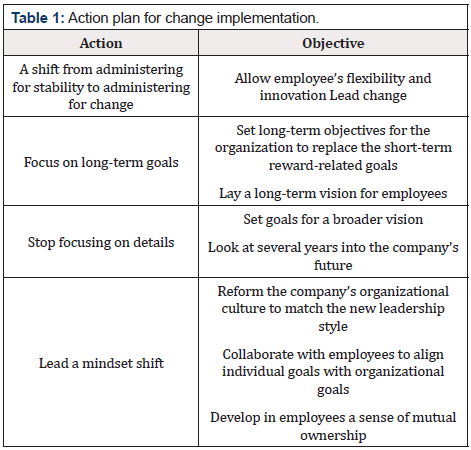Mini Review 
 Creative Commons, CC-BY
Creative Commons, CC-BY
Transactional Leadership
*Corresponding author: Ecler Jaqua, Department of Business Administration, Trident University International, USA.
Received: October 18, 2021; Published: October 28, 2021
DOI: 10.34297/AJBSR.2021.14.002021
Abstract
Transactional leadership is also called managerial leadership, and it is a type of leadership that focuses on the role of organization, group performance, and supervision. Transactional leaders focus on assigning specific tasks to their employees and using the reward and punishment system to motivate employees towards achieving their individual and organizational goals. Some characteristics of transactional leadership are focusing on short-term goals, procedures, and policies that are favor-structured, focusing on doing things correctly and rules, inflexibility and opposition to change.
Keywords: Leadership; Management; Business; Performance; Organization
Introduction
Leaders of large companies and multinational corporations use transactional leadership styles to get things done the right way to achieve their organization’s goals. A classic illustration of a company that uses transactional leadership is Hewlett Packard (HP), a multinational information technology company based in America with its headquarters in Palo Alto, California. The company deals in hardware components and software services and other related services to its consumers, medium and small businesses. The company uses transactional leadership in its tribal stage 3 to ensure employees meet their goals.
Discussion
Hewlett Packard uses transactional leadership by using rewards and punishment to influence the performance of its workers. Workers on tribal stage 3 highly regard their place in the organization. Managers in the tribal stage use rewards and punishments to influence workers to achieve their goals and thus the organization’s goals. The company follows the rules, procedures, and standards to ensure employees achieve their set goals. There is a constant assessment to ensure employees are rewarded when they succeed or punished when they fail. Leaders have set standards and expectations to monitor performance and ensure employees work hard to achieve set goals and objectives Baškarada, et al. [1]. For example, HP rewards employees who volunteer extra working hours for the company’s benefit. It partnered with Network for Good to reward employees who volunteer at least ten work hours per quarter. The company gives them a $50 Good Card when they achieve the set target. Transactional leadership at HP affects employees both positively and negatively. It motivates employees to strive for excellence because they know there is a reward. In striving to get the reward, employees meet their individual and organizational goals Baškarada, et al. [1]. A worker’s performance is motivated by expectancy, motives and incentives. When an employee expects a good thing, they work hard and do everything it takes to get it. Transactional leadership specifies employee’s roles and tasks, hence stimulating the self-interests of employees based on the reward that awaits them if they perform well. Employees complete the volumes of tasks assigned to them, meaning they deliver quality and quantity based on the set targets to ensure they get the reward. Overall, this leadership style improves performance. HP’s leadership style failed due to several reasons.
The changes recommended should move its leadership from a transactional to a transformational leadership style. The first thing to change is to shift from administering for stability to administering for change Mumford, et al. [2]. Transactional leadership focuses on order and stability and does not allow flexibility among employees. Employees should follow the rules and procedures, which may hamper innovation. Therefore, to shift to transformational leadership, managers at HP should lead change in the company. The second thing to change is the focus on longterm goals. Transactional leadership focuses on short-term goals Baškarada, et al. [1]. To shift from this, managers should lay a longterm vision for employees to achieve. The third thing to change is to avoid focusing on details. This means that managers at HP should set goals for a broader vision that looks beyond the present and focuses on several years into the company’s future Mumford, et al. [3]. Finally, managers should lead a mindset shift by collaborating with their employees to reform their culture. It means allowing employees to realize the company’s vision by fostering flexibility in their actions and accepting diverse perceptions, viewpoints, and beliefs Katz [4]. See Table 1 for more information about change implementation action plans. Lastly, employees should develop a sense of mutual ownership to encourage them to participate in the ethical decision-making process for the good of the organization and their own good.
Conclusions
In conclusion, transactional change has its benefits in organizations. However, modern companies and large corporations need transformational leaders to cope well with the emerging business challenges and globalization. For example, the HP Company uses transactional leadership on its employees at the tribal stage 3 of the organization. The employees work hard to achieve their targets to get a reward in the form of praise or reward. When they succeed, they get a prize, and when they fail, they get a punishment. This action impacts performance both positively and negatively by influencing motivation. To change from transactional to transformational leadership, managers at the tribal stage 3 should shift from administering for stability to assisting change [3]. They should also stop focusing on details and focus on long-term goals. They should also lead a mindset shift among the employees to change the organizational culture.
References
- Baškarada S, Watson J, Cromarty J (2017) Balancing transactional and transformational leadership. International Journal of Organizational Analysis.
- Mumford MD, Zaccaro SJ, Harding DF, Jacobs TO, Fleishman EA (2000) Leadership skills for a changing world: Solving complex social problems. The Leadership Quarterly 11(1): 11-35.
- Business Source Complete, AN Accession Number: 6774557. Available in the Trident Online Library.
- Katz RL (1955) Skills of an Effective Administrator. Harvard Business Review 33(1).




 We use cookies to ensure you get the best experience on our website.
We use cookies to ensure you get the best experience on our website.